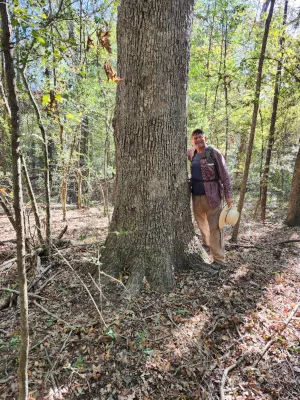
In October 2024, the Houston Regional Group and Lone Star Chapter of the Sierra Club (Sierra Club) visited and hiked Compartment 68, Sam Houston National Forest (SHNF), to collect information to provide to the U.S. Forest Service (FS) about the proposed Compartments 52, 54, and 68 Mulching Project.
Compartment 68, where the Sierra Club hiked, has a large powerline right-of-way (ROW), a ROW along Forest Road (FR) 281, and other open areas where many wildflowers and grasses bloom such as:
Canadian Goldenrod, Blue Mistflower, Wooly Croton, two Liatris species (gayfeather/blazing star), Switch Grass, Little Bluestem, False Foxglove, Palafoxia, Gumweed, False Goldenrod, Purpletop, Lobelia, Swamp Sunflower, Longspike Tridens, and others. Butterflies that include Gulf Fritillary, Variegated Fritillary, Buckeye, and Sulfur feed on wildflowers.
Some of the forest plants that the Sierra Club saw as it walked the tributary to Gourd Creek (TGC) and Gourd Creek included:
Water Oak, American Holly, Yaupon Holly, greenbriar, Fringe Tree, Flowering Dogwood, Farkleberry, American Holly, grape vine, Yellow Passion Vine, Southern Magnolia, Eastern Hophornbeam, Black Gum, native privet, Carolina Jessamine, Southern Wax Myrtle, White Ash, Sweetgum, Winged Elm, Deciduous Holly, Christmas Fern, Elephant-foot, Loblolly Pine, Southern Red Oak, White Oak, Red Maple, Parsley Hawthorn, Dwarf Palmetto, and Red Mulberry.
The farther downstream that you walked on the TGC and Gourd Creek the more swales, depressions, and other stream characteristics were seen along with large hardwood trees. We found several areas that had numerous large White Oaks, Southern Red Oaks, Sweetgum, and Black Gum trees.
The Sierra Club provided the FS with a series of management recommendations which included:
1. We found the gate unlocked on Forest Road (FR) 281 and wanted to report this to the FS in case the gate should be locked.
2. The FS should protect large upland hardwoods in Stands 4 and 29. These trees are some of the largest and most mature upland hardwoods that the Sierra Club has seen in SHNF.
3. On the powerline ROW, just south of FR 281, a large area has been rutted. The ruts in some places were 1-2 feet deep. The entire area was about 300 feet long and 97 feet wide. The soil is sandy here. The FS should investigate what this disturbed area is and ensure that the rutted area has mitigation measures implemented.
4. The FS should ensure that the Gourd Creek culvert, which blew out, is replaced and positioned so that erosion is prevented and aquatic life can migrate upstream.
5. The FS should ensure that eroded areas on the powerline ROW have mitigation measures implemented to stop and prevent erosion.
6. The culvert for the TGC on the powerline ROW isn’t level with the bed of the stream and should be repositioned so that it doesn’t stop migration of aquatic life.
7. The FS should contact the powerline company and the Corps to determine if the rock and dirt fill placed downstream from the TGC culvert is legal. It can then be determined what should be done to mitigate the damage including repositioning of the culvert so that it rests on the bed of the TGC.
8. It may be appropriate to prescribe burn more carefully along both the TGC and Gourd Creek since soils are sandy and are erosion prone.
9. Several areas on the TGC and Gourd Creek have numerous large White Oaks, Southern Red Oaks, Sweetgum, and Black Gum trees. These hardwood areas, which may be 50-100 or more feet wide, shouldn’t be purposefully burned, mulched, or have other silvicultural activities implemented. They should be made a part of protected streamside management zones.
The Sierra Club will continue its efforts to ensure that proposed forest projects are greener in SHNF.